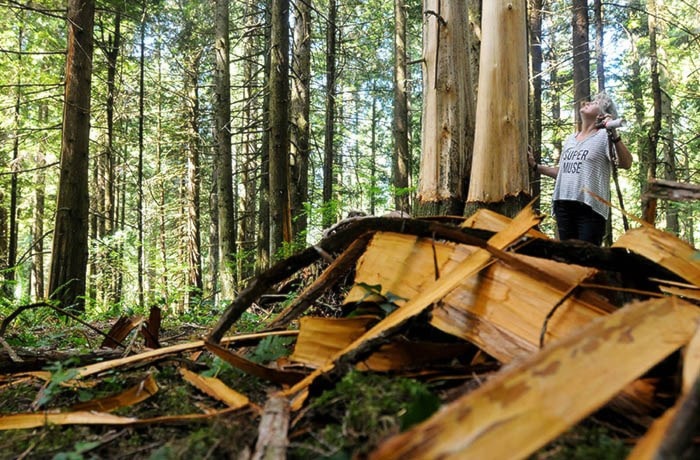Jana Kaderabek enjoys hikes to Mike Lake in Golden Ears Provincial Park, where the tall trees shelter trails from the outside world.
But lately, the sight of majestic cedars shorn of their bark, by the park in an area slated for logging, is making the walk a little less pleasant.
Kaderabek says that on the trail that leads to the lake, between 40 and 50 cedars have had the bark removed for several metres up the tree.
She complained to a park ranger, who told her First Nations bands can strip the bark and use it for handicrafts, such as making baskets.
Kaderabek is worried that removing the bark will kill the trees.
“If it is First Nations, somebody should be supervising them, no?” she said. “It’s just terrible. I love that Golden Ears Provincial Park. That is my health.”
She’s also upset about extra bark left lying on the ground and wonders why that’s allowed to happen in a park that receives thousands of visitors.
Chief Susan Miller, with the Katzie First Nation, said other bands, such as Tsawwassen First Nations, have agreements with Katzie that allows them in the area to remove bark for the use in handicrafts.
“This year, we’ve had an abundance of requests. We’ll actually be having a meeting … to determine how we’re going to address potential over harvesting.”
Recently, a group and some individuals came out from Tsawwassen, while Vancouver school district and an aboriginal mothers group from Vancouver also took some bark.
“We try to honour them while we can, but we do recognize we will have to put some limits on how much is going to be harvested, because we can’t take away Katzie’s first right to access the cedar,” Miller said.
Removing bark from a tree is recognized as a traditional practice. And according to the Ministry of Environment, Tsawwassen First Nation has the right to harvest and gather plants within Golden Ears Provincial Park for domestic purposes, subject to an approved gathering plan.
“The overall quantity and extent of First Nation’s cedar bark harvest in Golden Ears Park is unknown, however this activity does not pose a conservation or management concern.”
So far, the cedar bark harvest has been minimal.
Miller said when members of the Tsawwassen First Nation come out to Maple Ridge, they’ll stop by and give an offering or tobacco pouch, recognizing they’re in Katzie territory.
According to the ministry, the way to harvest bark without harming the tree is to remove the bark only in the shape of a long, narrow triangle, which keeps the tree alive and allows the bark to regrow.
But about at least 20 trees, probably more, had the bark removed from most of the circumference of the tree, leaving only a narrow strip of bark intact.
Miller said if the bark is removed to that extent, it could be “because those trees are slated to come down anyways.”
But Jennie Aikman, with B.C. Parks, said the area where the bark was removed was actually in the UBC Malcolm Knapp Research Forest. And that area of the forest is slated for harvest, which is why the bark was removed from entirely around the trees.
Usually, only a strip of about 30 centimetres wide is taken so that the tree can recover and produce more bark later.
The way the bark was taken, from around the girth of the entire tree, “that kind of removal of bark is completely inconsistent with traditional practice,” Aikman said.
Most of the bark harvesting occurs within the research forest rather than the park, she added.
